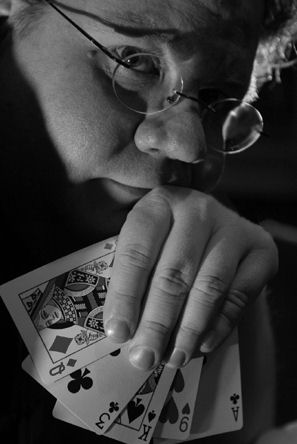An Evening of Mystery
The weekend finishes up with a show.
The always classy David Charvet acts as our host for the evening. During his part of the show, David will pull out a couple of historical pieces and one of his own. One was a favorite small piece of Jack Gwynne’s in which two drinking glasses are placed mouth down on a board. The board is turned upside down and the glasses stay impossibly “stuck” to the board. David also performed a fine version of his the jumbo nest of boxes. Last, he performs the Rag Picture that he spoke about earlier. David is a classically styled magician. He is entertaining but plays it straight and that is ill suited to this routine. Mostly, he built the pictures while music played. This is not an act. It is certainly possible that there is no entertainment to find in Rag Pictures. I can only imagine how different it would have been if it were performed by someone with more comedic skills instead.
John Carney was also on the show. He performed as he always does, sort of low key fun with impeccable sleight of hand. I hesitate to say too much because John will be performing in Galena, IL five days a week through October and these tricks will be in his one man show. Yet…he performed a multi-phase routine in which several small wooden balls appear, multiply, and disappear. He treated us to a live performance of the hat and glass routine he featured on the David Letterman show. Last, he did a classic Egg Bag routine.
The closer on the bill is Murry Hatfield & Teresa. They are a quality illusion act that has been touring extensively for many years. Their performance style is mostly audience pleasing, but standard fare for the magic set. They performed Jim Steinmeyer’s puzzling Op Art, a bag escape, a rope routine. They finished up with a routine where Teresa was chained to a table and covered by a box. The box, and Teresa, where penetrated with four swords through the top and the entire box was trisected by three large shields leaving her no place to be.
The End
I guess the real question is: “Was the Weekend a success?” The short answer is yes.
It was imperfect, much of it rested on the presenters and not the organizers fault. It is something that can be fixed. Some innovations from the first year were abandoned. Some of what worked the year before wasn’t built on. I am also sure that my opinions may not always be the same as others.
Attendance was slightly down. Investigation will be needed to figure out the reasons behind the drop. After last year’s success attendance should have climbed. More outreach and education may help improve things. There are some rumors that it may go to every two years instead of being a yearly convention. This would be a sad loss for Chicago.
I did like the themed sets and panel discussions. I did like the bringing in of some of our older icons. They are our last links to a show business that doesn’t exist any more. There are precious few magicians left like Jack Kodell and Celeste Evans. They need to be celebrated more.
As I’ve said many times before, for me these conventions are increasingly more about the people I get to spend time with than the actual programs. I still want the programs to be quality. It makes it easier to survive and later write about. But more often it is the personal, not the public, moments I look to cherish. (Last year’s experience of Walter Zaney Blaney’s final performance was the rare public moment from last year that trumped all other memories.)
There is nothing more exhilarating than spending time with some endless intriguing person, especially when found quite unexpectedly. It is this moment that takes my breath away. You should be looking for your moment also.
It is this thought that keeps me from wanting to rejoin the real world on Sunday. These few precious moments in time that I want to put my arms around and hold on—and, if I can’t make it last forever, then maybe it can last a day, an hour, or even a minute longer.
You can see some pictures, get information about the Magic Collectors Association, and find out about next year’s convention at the Magicol Blog: http://magicol.wordpress.com/
